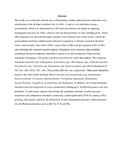Plant Parasitic Nematodes Associated With Coffee In Kenya

View/
Date
2011Author
Nzesya, J.M.
Kimenju, J.W.
Muiru, W.M.
Mutua, G.K.
Wachira, P.M.
Type
PresentationLanguage
enMetadata
Show full item recordAbstract
This study was conducted with the aim of determining whether plant parasitic nematodes were
contributing to the decline in productivity of coffee. A survey was undertaken using a
questionnaire which was administered to 200 farms households and aimed at capturing;
management practices in coffee, cultivars and soil characteristics at each sampling point. About
200 composite root and soil rhizospere samples were collected from coffee farms, (where the
questionnaires had been administered) selected at random in 11 districts located in the three
coffee zones namely; Tea-coffee (UM1), main coffee (UM2) and the marginal coffee (UM3)
zone including the regional research stations. Nematodes were extracted using modified
centrifugal floatation technique, identified to genus level and enumerated. Plant parasitic
nematodes belonging to 20 genera were recovered from the coffee rhizosphere. The dominant
nematodes detected were of the genera; Tylenchulus spp., Meloidogyne spp., Tylenchorhynchus,
Pratylenchus spp., Tylenchus spp, Rotylenchus spp, Hemicyclophora spp with an abundance of
167, 161.,160, 158.0, 156., 148, 139 juveniles/200 cm3 soil, respectively. Other plant nematodes
found in the coffee fields included: Helicotylenchus and Scutellonema spp. Hoplolaimus,
Hemicroconema, Criconema, Aphelenchoides, Trichodorus, Bunonema, Radopholus,
Paratrichodorus, Longidorus, Scutellonema and Xiphinema. In addition, free-living nematodes
(bacteriovores and fungivores as well as predaceous) belonging to 10 different genera were also
identified. A multivariate analysis showed that the population densities of plant parasitic
nematodes and composition nematode community varied significantly (P=0.01) among coffee
growing zones partly caused by the differences in farm management practices which impacted
on soil chemical properties such as pH, Na, P, K and Mn.
